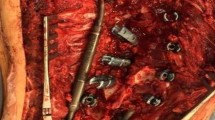Abstract
Coronal decompensation following correction of adolescent idiopathic scoliosis (AIS) has been reported to be due to the Cotrel-Dubousset rod derotation maneuver, or to a hypercorrection of the main thoracic curve. The treatment of such decompensation consists classically in observation, bracing, or extension of the instrumentation in the lumbar spine for a King 2 curve, or in the upper thoracic spine for a King 5 curve. As the postoperative decompensation is related to a hypercorrection of the main thoracic curve (relative to the compensatory curve), we hypothesized that if we were to “let the spine go” to some of its initial deformity, the balance of the patient would be improved. The purpose of the study was therefore to report on two cases where a postoperative imbalance following scoliosis surgery was successfully treated by decreasing the correction of the main thoracic curve. Two patients with AIS were found to have significant imbalance after scoliosis surgery. Both patients had been treated for a right thoracic curve (82° and 85° respectively) with an anterior release and posterior instrumentation. The revision surgery consisted for both patients in removing all the hooks between the end vertebrae of the main thoracic curve. This was done before the 3rd postoperative month for both patients. After revision surgery, the balance of both patients improved dramatically within a few weeks. The shoulders became almost level, and the trunk shift improved concomitantly. The Cobb angle increased by 8° and 10°, and the apical vertebra shifted to the right by ¶15 and 10 mm for the respective patients. These results were stable at 1-year follow-up. In the event of a persisting imbalance, we recommend, in selected cases, letting the spine go by removing all the implants located between the end vertebrae of the main thoracic curve. This adjustment or fine-tuning of the instrumentation should be done before the fusion takes place, and is best achieved with an instrumentation in which the hooks can be easily removed from the rod.
Similar content being viewed by others
Author information
Authors and Affiliations
Additional information
Received: 15 July 1999/Revised: 1 December 1999/Accepted: 16 December 1999
Rights and permissions
About this article
Cite this article
Arlet, V., Marchesi, D., Papin, P. et al. Decompensation following scoliosis surgery: treatment by decreasing the correction of the main thoracic curve or “letting the spine go”. E Spine J 9, 156–160 (2000). https://doi.org/10.1007/s005860050227
Issue Date:
DOI: https://doi.org/10.1007/s005860050227




